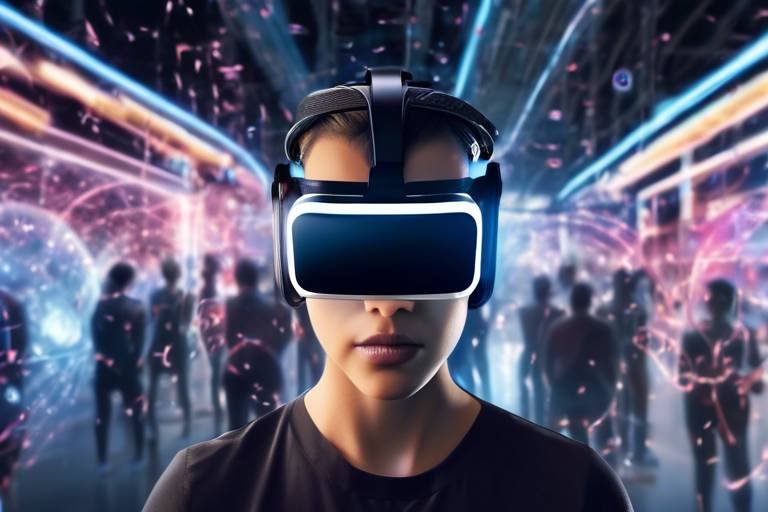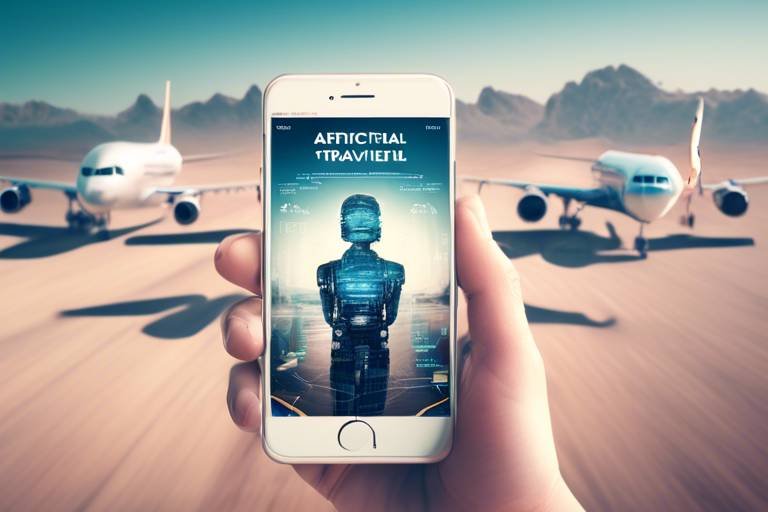Transforming the Future of Libraries with AI
Welcome to the new age of libraries, where artificial intelligence (AI) is not just a buzzword but a transformative force reshaping the way we interact with information. Imagine stepping into a library that knows your preferences, suggests your next favorite book, and helps you find resources with just a few clicks. Sounds like something out of a sci-fi movie, right? But this is the reality we are approaching. Libraries are evolving from traditional repositories of knowledge into dynamic hubs of learning and engagement, all thanks to AI.
As we dive deeper into this transformation, it’s important to recognize that AI is not merely an add-on; it’s a game changer. It enhances user experiences, automates mundane tasks, and improves accessibility for everyone. Whether you're a student, a researcher, or just a curious mind, AI is making it easier than ever to access the information you need. This article will explore the exciting ways in which AI is revolutionizing libraries, making them more user-friendly, efficient, and inclusive.
Think about it: how often have you wandered through the aisles of a library, overwhelmed by the sheer volume of choices? With AI, libraries can analyze your reading habits and preferences, offering personalized recommendations that guide you to the materials you’re most likely to enjoy. This is not just about convenience; it’s about creating a more engaging and meaningful experience for every patron.
Moreover, the administrative side of libraries is also benefiting from AI. Imagine librarians freed from the shackles of routine tasks, allowing them to focus on strategic initiatives that enhance community engagement. This shift not only improves service delivery but also transforms the role of librarians into community leaders and innovators.
As we explore the various facets of AI in libraries, from chatbots providing 24/7 support to data-driven decision-making, it becomes clear that the future of libraries is bright. The integration of AI is not just about keeping up with technological advancements; it’s about ensuring that libraries remain relevant and accessible in an ever-changing world.
- How is AI improving user experience in libraries?
AI enhances user experience by providing personalized recommendations and streamlining access to resources, making it easier for patrons to find what they need. - What role do chatbots play in libraries?
Chatbots offer instant assistance, answering queries and guiding users through services, thus improving overall satisfaction and efficiency. - How does AI help in making libraries more accessible?
AI-driven assistive technologies and language translation services ensure that library resources are accessible to diverse populations, including those with disabilities and non-native speakers. - What future trends can we expect in library AI?
Future trends may include integration with virtual reality for immersive learning experiences and the use of predictive analytics to anticipate user needs.

Enhancing User Experience
In the digital age, where information is just a click away, libraries are stepping up their game to remain relevant and engaging. AI technologies are at the forefront of this transformation, revolutionizing how patrons interact with library services. Imagine walking into a library that knows your preferences, suggests books you’d love, and even remembers your past visits. Sounds like a dream, right? Well, that dream is becoming a reality thanks to artificial intelligence.
One of the most exciting aspects of AI in libraries is its ability to provide personalized recommendations. By analyzing user behavior and preferences, AI can curate lists of books, articles, and resources tailored to individual tastes. This not only makes it easier for patrons to discover relevant materials but also enhances their overall experience. Think of it as having a personal librarian at your fingertips, always ready to suggest your next great read!
Moreover, AI streamlines access to resources, making it incredibly user-friendly. Gone are the days of sifting through endless catalogs or waiting in line for assistance. With AI-driven systems, patrons can easily navigate through digital collections, databases, and online resources. This seamless access not only saves time but also encourages users to explore more of what the library has to offer.
To illustrate the impact of AI on user experience, consider the following table that highlights some key features:
| Feature | Description |
|---|---|
| Personalized Recommendations | AI analyzes user data to suggest books and resources tailored to individual interests. |
| Streamlined Access | Users can easily navigate digital collections and resources without hassle. |
| Interactive Interfaces | Engaging and intuitive interfaces enhance the overall user experience. |
Furthermore, the integration of AI creates more interactive interfaces that captivate users. Libraries are moving beyond traditional layouts, embracing innovative designs that encourage exploration and discovery. Imagine a virtual reality setup where you can step into a historical scene or an interactive map that guides you through various genres. These experiences not only make libraries more attractive but also foster a deeper connection between patrons and the resources available.
In conclusion, the enhancements brought about by AI are not just about technology; they are about creating a more engaging, personalized, and efficient experience for library users. As libraries continue to evolve, embracing these innovative technologies will ensure they remain vital community hubs that cater to the diverse needs of their patrons.
- How does AI personalize recommendations in libraries?
AI uses algorithms to analyze user data, such as borrowing history and preferences, to suggest relevant materials. - What are the benefits of streamlined access to resources?
Streamlined access saves time and encourages users to explore more resources without frustration. - Can AI enhance the physical library experience?
Yes, AI can create interactive experiences through virtual reality and engaging interfaces.

Automating Library Operations
The integration of artificial intelligence (AI) into library operations is not just a trend; it's a game-changer. Imagine a world where librarians are no longer bogged down by tedious administrative tasks, allowing them to focus on what truly matters—serving the community and enhancing the user experience. AI technologies can take over repetitive functions such as cataloging, inventory management, and even checking in and out materials. This means librarians can devote their time to engaging with patrons, developing programs, and curating collections that resonate with their community.
One of the most significant advantages of AI in libraries is its ability to streamline operations. For instance, AI can automate routine tasks like:
- Book check-ins and check-outs
- Automatic reminders for due dates
- Data entry for new acquisitions
By using AI-driven systems, libraries can ensure that these tasks are completed accurately and efficiently, reducing the likelihood of human error. This not only saves time but also enhances the overall efficiency of library operations. With AI handling the mundane, librarians can shift their focus towards more strategic initiatives that engage the community and enhance service delivery.
One of the most exciting applications of AI in libraries is the implementation of chatbots. These intelligent virtual assistants can provide instant assistance to library users, answering their queries and guiding them through various services. Imagine a user who has a question about their account or needs help finding a specific book. Instead of waiting in line or searching through the library's website, they can simply interact with a chatbot, receiving immediate answers and support. This not only improves user satisfaction but also boosts the efficiency of library operations.
Another remarkable feature of AI chatbots is their 24/7 availability. Libraries often have fixed hours, but with AI, users can access information and assistance whenever they need it. Whether it's late at night or during a holiday, the library can still provide support, ensuring that users feel connected and valued. This around-the-clock service is particularly beneficial for students and researchers who may require assistance outside traditional hours.
AI can also enhance user experience through personalized recommendations. By analyzing user behavior and preferences, AI systems can suggest tailored resources that align with individual interests. For example, if a patron frequently checks out science fiction novels, the AI can recommend new arrivals in that genre or similar authors. This level of personalization not only makes it easier for patrons to discover relevant materials but also fosters a deeper connection between the library and its users.
Moreover, AI empowers libraries to harness data analytics, enabling informed decision-making regarding acquisitions, programming, and resource allocation. By analyzing trends and user data, librarians can better understand what their community needs and desires. This means they can stock up on popular titles, create programs that resonate with their audience, and allocate resources effectively. The result? A library that is not only responsive but also anticipates the needs of its patrons.
In summary, automating library operations through AI not only enhances efficiency but also transforms the role of librarians. By freeing them from mundane tasks, libraries can evolve into dynamic community hubs where innovation, engagement, and personalized service thrive.
Q1: How does AI improve library operations?
AI improves library operations by automating routine tasks, allowing librarians to focus on community engagement and service delivery.
Q2: Can AI chatbots assist patrons at any time?
Yes, AI chatbots can provide 24/7 assistance, ensuring that patrons receive support whenever they need it.
Q3: How does AI provide personalized recommendations?
AI analyzes user behavior and preferences to suggest tailored resources, enhancing the discovery of relevant materials.
Q4: What role does data analytics play in libraries?
Data analytics helps libraries make informed decisions about acquisitions and programming based on user needs and trends.

Chatbots for Customer Service
In today's fast-paced world, chatbots have emerged as a game-changer for libraries, acting as the frontline warriors in customer service. Imagine walking into a library, and instead of searching aimlessly for a staff member to answer your questions, you encounter a friendly chatbot ready to assist you at any moment. These AI-driven assistants are not just tools; they are transforming the way we interact with library services, making them more efficient and accessible.
One of the most significant advantages of implementing chatbots in libraries is their ability to provide instant assistance. Users can ask questions about library hours, upcoming events, or even how to find a specific book, and receive immediate responses. This not only enhances the user experience but also significantly reduces the workload on librarians, allowing them to focus on more complex inquiries and community engagement activities.
Moreover, the 24/7 availability of chatbots ensures that library patrons can access information and support whenever they need it. Whether it’s late at night or during a holiday, these virtual assistants are always on duty, ready to guide users through the library's resources. This constant availability breaks down barriers and ensures that everyone, regardless of their schedule, can benefit from library services.
Additionally, chatbots can provide personalized recommendations based on user interactions and preferences. By analyzing past queries and behaviors, they can suggest relevant books, articles, or events tailored to individual interests. This personalized touch not only enhances user satisfaction but also encourages patrons to explore new resources they might not have discovered otherwise.
To illustrate the impact of chatbots in libraries, consider the following table that outlines key benefits:
| Benefit | Description |
|---|---|
| Instant Assistance | Provides immediate answers to user inquiries, improving satisfaction. |
| 24/7 Availability | Ensures users can access information at any time, breaking down barriers. |
| Personalized Recommendations | Suggests resources based on user behavior, enhancing discovery. |
| Reduced Workload for Librarians | Allows librarians to focus on more complex tasks and community engagement. |
In conclusion, chatbots are not just a passing trend; they are a vital component of modern library services. By providing instant answers, being available around the clock, and offering personalized recommendations, they enhance the overall user experience while allowing librarians to dedicate their time to more impactful initiatives. As libraries continue to evolve, embracing AI technologies like chatbots will undoubtedly lead to a more engaging and accessible environment for all patrons.
- How do chatbots work in libraries? Chatbots use artificial intelligence to understand user queries and provide relevant information instantly.
- Are chatbots available 24/7? Yes, chatbots can operate around the clock, offering assistance whenever needed.
- Can chatbots recommend books? Absolutely! Chatbots analyze user preferences to suggest tailored reading materials.
- Do chatbots replace librarians? No, they complement librarians by handling routine inquiries, allowing librarians to focus on more complex tasks.

24/7 Availability
In our fast-paced world, immediacy is key, and libraries are stepping up to meet this demand through the implementation of AI-driven chatbots. Imagine needing information at 2 AM about a book for your research project or assistance with accessing digital resources. With AI, libraries can now offer support around the clock, ensuring that help is just a click away, no matter the hour. This constant availability transforms the traditional library experience, making it more accessible and user-friendly.
AI chatbots are programmed to handle a variety of inquiries, from simple questions about library hours to more complex requests for research assistance. They can guide users through the library’s digital catalog, help locate e-books, and even provide information on upcoming events and programs. This not only enhances user satisfaction but also ensures that patrons feel supported in their quest for knowledge, regardless of when they choose to engage with library services.
Furthermore, the 24/7 availability of AI-driven support can significantly reduce the workload on library staff. With chatbots handling routine inquiries, librarians can devote more time to strategic initiatives that foster community engagement and enhance service delivery. This shift allows libraries to not only maintain their relevance in an increasingly digital world but also to thrive as community hubs of learning and information.
To illustrate the impact of 24/7 availability, consider the following table, which compares traditional library hours with the new AI-enhanced model:
| Aspect | Traditional Library Hours | AI-Enhanced Library Services |
|---|---|---|
| Availability | Limited hours (e.g., 9 AM - 5 PM) | 24/7 access to information and support |
| User Engagement | Dependent on staff availability | Continuous engagement through AI |
| Staff Workload | High during peak hours | Reduced routine inquiries handled by AI |
| Patron Satisfaction | Limited to library hours | Increased satisfaction due to immediate support |
In conclusion, the integration of AI chatbots into library services is a game-changer. By providing , libraries are not just keeping pace with the demands of modern users; they are redefining what it means to be a community resource. As we move forward, it will be exciting to see how libraries continue to innovate and adapt to serve their patrons better, ensuring that knowledge and assistance are always within reach.
- What are AI chatbots? AI chatbots are automated programs that can simulate conversation and provide assistance to users in real-time.
- How do AI chatbots improve library services? They provide 24/7 support, handle routine inquiries, and allow librarians to focus on more complex tasks.
- Can I access library resources at any time? Yes, with AI chatbots, you can access information and assistance whenever you need it.
- Are AI chatbots effective? Yes, they enhance user satisfaction by providing quick and accurate responses to inquiries.

Personalized Recommendations
In the vast ocean of information that libraries offer, finding the right resource can sometimes feel like searching for a needle in a haystack. This is where come into play, transforming the way patrons interact with library collections. By leveraging the power of artificial intelligence, libraries can now analyze user behavior and preferences to provide tailored suggestions that resonate with individual interests. Imagine walking into a library that knows your favorite genres, authors, and even your reading pace. Sounds like a dream, right? But with AI, this is becoming a reality.
The process begins with data collection. Libraries can gather insights from various sources, such as borrowing history, search queries, and even user ratings. This data is then processed through advanced algorithms that identify patterns and preferences. For instance, if a user frequently checks out science fiction novels, the system can suggest new releases in that genre or even recommend related genres like fantasy or speculative fiction. This not only enhances the user experience but also encourages patrons to explore new materials that they might not have considered otherwise.
Moreover, personalized recommendations can significantly improve user engagement. When patrons receive suggestions that align with their interests, they are more likely to visit the library more frequently, participate in programs, and utilize digital resources. This creates a dynamic library environment where users feel valued and understood. In a way, it’s like having a personal librarian who knows exactly what you need, when you need it.
To illustrate the impact of personalized recommendations, consider the following table that highlights the benefits for both patrons and libraries:
| For Patrons | For Libraries |
|---|---|
| Enhanced discovery of resources | Increased user engagement |
| Time-saving in finding relevant materials | Better resource allocation based on user trends |
| Improved satisfaction and loyalty | Informed programming and acquisitions |
In conclusion, the integration of personalized recommendations powered by AI is revolutionizing the library experience. It fosters a more engaging and user-friendly environment, making it easier for patrons to discover materials that truly resonate with them. As libraries continue to embrace these technologies, the future looks bright for both users and librarians alike, paving the way for a richer, more connected community of readers.
- How do libraries collect data for personalized recommendations?
Libraries gather data from various interactions, including borrowing history, user ratings, and search queries to understand patron preferences. - Are personalized recommendations available for digital resources?
Yes, many libraries provide personalized recommendations for both physical and digital resources, enhancing the overall user experience. - Can personalized recommendations help discover new genres?
Absolutely! AI algorithms can suggest related genres based on your reading history, encouraging you to explore new areas of interest.

Data-Driven Decision Making
In the rapidly evolving landscape of libraries, has emerged as a crucial component for enhancing service delivery and meeting the diverse needs of patrons. By harnessing the power of artificial intelligence and data analytics, libraries can transform raw data into actionable insights that guide their strategic initiatives. Imagine a librarian equipped with a crystal ball that not only predicts what books will be popular next month but also identifies gaps in the current collection. This is the reality that AI brings to libraries today.
One of the most significant advantages of implementing AI in libraries is the ability to analyze vast amounts of data efficiently. Libraries collect a wealth of information from user interactions, borrowing patterns, and program attendance. By utilizing AI algorithms, they can process this data to uncover trends and preferences among their users. For example, if data shows that a particular genre is consistently checked out more than others, libraries can make informed decisions about acquiring more titles in that genre, ensuring they meet the demands of their community.
Moreover, AI can assist in evaluating the effectiveness of library programs and services. By analyzing feedback and participation rates, libraries can determine which initiatives resonate with their audience and which ones may need reevaluation. This leads to a more responsive library environment, where services are continuously adapted to better serve the community. Think of it as a feedback loop where the library is always in tune with its patrons, leading to enhanced satisfaction and engagement.
To illustrate the impact of data-driven decision making, consider the following table that highlights key areas where AI can influence library operations:
| Area of Impact | Description | Benefits |
|---|---|---|
| Collection Development | Analyzing borrowing trends to inform acquisitions | Ensures popular materials are available |
| Program Evaluation | Assessing participation and feedback for library events | Improves future programming and resource allocation |
| User Experience Enhancement | Personalizing services based on user data | Increases patron satisfaction and engagement |
In conclusion, the integration of AI into library systems not only streamlines operations but also empowers librarians to make informed decisions that directly benefit the community. As libraries continue to embrace technology, the emphasis on data-driven strategies will only grow, paving the way for a more innovative and responsive approach to information management. By prioritizing the needs of users through data analytics, libraries can ensure they remain relevant and invaluable resources in the digital age.
- How does AI improve library services? AI enhances library services by providing personalized recommendations, automating tasks, and analyzing user data for better decision-making.
- What types of data does a library collect? Libraries collect data on book checkouts, program attendance, user feedback, and digital resource usage, among other metrics.
- Can AI help with accessibility in libraries? Yes, AI technologies can provide assistive tools and services that make library resources more accessible to individuals with disabilities.

Improving Accessibility
In today's diverse society, making information accessible to everyone is not just a goal; it's a necessity. AI technologies are leading the charge in transforming how libraries serve all community members, especially those with disabilities. Imagine walking into a library where every resource is within reach, regardless of your physical or cognitive abilities. This is the vision that AI is helping to bring to life.
One of the most significant advancements in this area is the development of assistive technologies. These tools are designed to enhance the reading experience for individuals with visual impairments or learning disabilities. For instance, AI-powered text-to-speech applications can read aloud digital books, making literature accessible to those who may struggle with traditional reading methods. Additionally, features like adjustable text sizes and background colors can be personalized to suit individual preferences, creating an inclusive environment where everyone can thrive.
Furthermore, language barriers can often hinder access to information. AI is breaking down these obstacles with real-time language translation services. Libraries can now offer multilingual resources and support, ensuring that non-native speakers feel welcomed and included. By providing materials in various languages, libraries can foster a sense of belonging and community among diverse populations. Imagine a library where a patron can seamlessly switch between languages, accessing the same wealth of information as everyone else!
To illustrate the impact of these technologies, consider the following table that showcases some of the most common assistive technologies being implemented in libraries today:
| Assistive Technology | Description |
|---|---|
| Text-to-Speech Software | Converts written text into spoken words, aiding those with visual impairments. |
| Screen Readers | Reads aloud the content displayed on a computer screen, providing accessibility for visually impaired users. |
| Adaptive Reading Tools | Includes features like adjustable font sizes and color contrasts to assist users with learning disabilities. |
| Language Translation Apps | Translates written text in real-time, helping non-native speakers access library resources. |
As we look to the future, the integration of AI in libraries will continue to evolve, offering even more innovative solutions to enhance accessibility. By prioritizing these advancements, libraries can ensure that they remain vital community hubs where everyone has the opportunity to learn, grow, and connect.
- How does AI improve accessibility in libraries?
AI enhances accessibility by providing assistive technologies and language translation services that make resources available to all users, including those with disabilities. - What types of assistive technologies are commonly used in libraries?
Common technologies include text-to-speech software, screen readers, and adaptive reading tools that cater to various needs. - Can non-native speakers benefit from AI in libraries?
Absolutely! AI-powered language translation services help non-native speakers access library resources in their preferred language.

Assistive Technologies
In today's fast-paced world, are becoming essential tools in libraries, ensuring that everyone, regardless of their abilities, can access information and resources. Imagine walking into a library where every patron, whether they have visual impairments, learning disabilities, or other challenges, can navigate through stacks of books and digital resources with ease. This is not just a dream; it is becoming a reality thanks to advancements in AI-driven assistive technologies.
At the heart of this transformation is the ability of AI to create adaptive tools that cater to individual needs. For instance, text-to-speech software allows visually impaired users to listen to books and articles rather than reading them. This technology can also be combined with screen readers, which convert digital text into spoken words, enabling users to interact with library catalogs and online resources effortlessly. Imagine being able to hear the titles of hundreds of books read aloud, making the selection process not only easier but also more enjoyable!
Moreover, AI can offer personalized learning tools that adapt to the user's pace and style of learning. For example, a student with dyslexia might benefit from software that highlights text as it is read aloud, helping them follow along more effectively. This kind of tailored support can significantly enhance the learning experience, making it more inclusive and engaging for all users. Libraries are now equipped with resources that can adjust to the needs of their patrons, creating an environment where everyone has the opportunity to thrive.
To illustrate the impact of these technologies, consider the following table that summarizes some of the most common assistive technologies available in libraries:
| Assistive Technology | Description |
|---|---|
| Text-to-Speech Software | Converts written text into spoken words, aiding visually impaired users. |
| Screen Readers | Reads aloud digital text, allowing users to navigate online resources. |
| Speech Recognition Software | Enables users to control devices and input text using their voice. |
| Adaptive Reading Tools | Tools that highlight text as it is read, aiding comprehension for users with learning disabilities. |
In addition to these technologies, libraries are increasingly adopting multimedia resources that cater to various learning styles. For example, video content with closed captions can help those who are hard of hearing, while interactive software can engage younger patrons in a fun and educational way. The goal is to create an inclusive environment where every patron feels welcome and empowered to explore the vast world of knowledge available to them.
As we look to the future, the integration of AI in assistive technologies will only continue to grow. Libraries have the potential to become even more accessible, ensuring that all community members can benefit from the wealth of resources they offer. By embracing these innovations, libraries are not just keeping pace with technological advancements; they are leading the charge toward a more inclusive and equitable information landscape.
- What are assistive technologies? Assistive technologies are devices or software designed to help individuals with disabilities access information and perform tasks more easily.
- How do libraries implement assistive technologies? Libraries implement these technologies by providing tools like text-to-speech software, screen readers, and adaptive reading tools to enhance accessibility for all patrons.
- Are assistive technologies only for individuals with disabilities? While primarily designed for those with disabilities, many assistive technologies can benefit all users by enhancing the overall experience and accessibility of resources.
- Can I suggest new assistive technologies to my local library? Absolutely! Libraries often welcome patron feedback and suggestions for new technologies that could improve services.

Language Translation Services
In an increasingly globalized world, libraries are not just places to borrow books; they are becoming vital hubs for community engagement and cultural exchange. One of the most exciting advancements in this transformation is the integration of AI-driven language translation services. These technologies break down the language barriers that can often hinder access to information and resources, ensuring that everyone, regardless of their linguistic background, can fully engage with library offerings.
Imagine walking into a library where every sign, brochure, and digital resource is instantly available in your native language. This is the power of AI translation services. By utilizing sophisticated algorithms and machine learning, libraries can now provide real-time translation for various languages. This not only enhances the user experience but also fosters a sense of belonging among diverse community members.
For instance, consider a library hosting a multicultural event. With AI translation tools, non-native speakers can receive instant translations of announcements and materials, allowing them to participate fully. This technology can be particularly beneficial for:
- Non-native speakers: Ensuring they understand library resources and events.
- Refugees and immigrants: Helping them integrate into the community by providing access to information in their preferred language.
- Students: Assisting them in their studies by translating educational materials and resources.
Furthermore, the implementation of these services doesn't just benefit individuals; it enriches the entire community. Libraries can host workshops and events that cater to multilingual audiences, fostering cultural exchange and understanding. In this way, AI translation services serve as a bridge, connecting people from various backgrounds and promoting inclusivity.
However, it's important to note that while AI translation services are incredibly useful, they are not infallible. Libraries must ensure that the translations are accurate and contextually appropriate. This might involve working alongside language experts or using a hybrid model that combines AI with human oversight to maintain quality and reliability.
As we look to the future, the role of language translation services in libraries will only grow. With advancements in AI technology, we can expect even more sophisticated tools that will continue to make information accessible for everyone. This evolution will not only enhance user experience but also solidify libraries as essential resources for learning and community cohesion in our diverse society.
Q: How do AI language translation services work in libraries?
A: AI language translation services use advanced algorithms and machine learning to translate text and speech in real time, making library resources accessible to non-native speakers.
Q: Are the translations provided by AI always accurate?
A: While AI translation services are highly effective, they may not always be 100% accurate. Libraries often supplement these tools with human oversight to ensure quality.
Q: Can language translation services help with library events?
A: Absolutely! AI translation services can provide real-time translations during events, allowing non-native speakers to fully participate and engage.
Q: What languages are typically supported by AI translation services in libraries?
A: Many AI translation services support a wide range of languages, but the specific languages available may vary by library. It's best to check with your local library for details.

Future Trends in Library AI
The future of libraries is poised for a remarkable transformation, largely driven by the advancements in artificial intelligence (AI). As we look ahead, several exciting trends are emerging that promise to reshape how libraries operate and serve their communities. One of the most promising developments is the integration of AI with virtual reality (VR). Imagine stepping into a library where you can not only read about ancient civilizations but actually experience them through immersive VR environments. This blend of information access and interactive exploration could revolutionize learning, making it not just informative but also incredibly engaging.
Moreover, the use of predictive analytics is set to become a game-changer for libraries. By analyzing data trends and user behavior, libraries can anticipate the needs of their patrons before they even step through the door. For instance, if a library notices an uptick in searches for materials on climate change, it can proactively curate relevant resources and programs, ensuring that the community's interests are met promptly. This data-driven approach will lead to more strategic resource allocation and programming, ultimately enhancing the overall user experience.
Additionally, we can expect to see a rise in collaborative AI tools that allow libraries to work together, sharing resources and insights. This could lead to the creation of a vast network of knowledge, where libraries can pool their data to better understand trends on a larger scale. Such collaboration can foster a sense of community not just among library users but also among the libraries themselves, promoting a culture of sharing and innovation.
As libraries embrace these future trends, they will also need to prioritize ethical considerations surrounding AI. Questions about data privacy, algorithmic bias, and the digital divide must be addressed to ensure that AI serves all community members equitably. Libraries can take the lead in implementing transparent AI practices, ensuring that technology enhances rather than hinders access to information.
In conclusion, the future of libraries with AI is not just about technology; it's about creating a more inclusive, engaging, and responsive environment for all users. As we navigate these changes, libraries will undoubtedly become more than just places to borrow books—they will evolve into dynamic community hubs that leverage the power of AI to enrich lives and foster lifelong learning.
- What is the role of AI in modern libraries? AI enhances user experience, automates operations, and improves accessibility.
- How can AI improve accessibility in libraries? AI technologies can provide assistive tools and language translation services, making resources available to everyone.
- What are predictive analytics? Predictive analytics involves using data to anticipate user needs and trends, allowing libraries to tailor their services accordingly.
- Will AI replace librarians? No, AI is designed to assist librarians, allowing them to focus on more strategic initiatives while automating routine tasks.
- How can libraries ensure ethical AI use? Libraries can implement transparent practices and address issues like data privacy and algorithmic bias to ensure equitable access.

Integration with Virtual Reality
The integration of Artificial Intelligence (AI) with Virtual Reality (VR) is poised to revolutionize the way libraries engage with their patrons. Imagine stepping into a virtual library where each aisle is a gateway to immersive experiences and interactive learning. This is not just a futuristic dream; it’s a reality that libraries are beginning to explore. By combining the analytical power of AI with the engaging environment of VR, libraries can create dynamic learning experiences that go beyond traditional methods.
One of the most exciting aspects of this integration is the potential for immersive storytelling. Libraries can develop virtual environments that allow users to experience stories in a way that feels almost tangible. For example, a patron could don a VR headset and find themselves in the midst of a historical event, interacting with characters and exploring settings that bring literature to life. This not only captures the imagination but also enhances comprehension and retention of information.
Moreover, the use of AI in these virtual settings can personalize the experience for each user. By analyzing individual preferences and learning styles, AI can tailor the VR environment to meet specific needs. For instance, if a user is particularly interested in science fiction, the AI could create a customized VR journey through a futuristic city, complete with interactive elements that align with their interests. This level of personalization ensures that every visit to the library is unique and engaging.
Additionally, the integration of VR can facilitate collaborative learning. Imagine students from different parts of the world coming together in a virtual classroom, guided by an AI facilitator. They can explore topics, share insights, and engage in discussions as if they were in the same physical space. This not only fosters a sense of community but also enriches the learning experience by exposing users to diverse perspectives.
As libraries embrace this technology, it’s essential to consider the technical requirements and infrastructure needed to implement VR effectively. Libraries must invest in high-quality VR equipment and ensure that staff are trained to assist patrons in navigating these new tools. Furthermore, accessibility should be a priority; it’s crucial to develop VR experiences that are inclusive for all users, including those with disabilities.
In conclusion, the integration of AI with VR in libraries opens up a world of possibilities. It transforms the traditional library setting into a vibrant hub of learning and exploration, where patrons can engage with information in innovative ways. As we look to the future, it’s clear that libraries that embrace these technologies will not only enhance their service delivery but also foster a deeper connection with their communities.
- What is the role of AI in libraries? AI enhances user experience by providing personalized recommendations and automating library operations.
- How can VR improve library services? VR creates immersive learning environments that engage patrons and enhance their understanding of materials.
- Are there accessibility concerns with VR in libraries? Yes, it's essential to develop VR experiences that cater to all users, including those with disabilities.
- What are the future trends for AI and VR in libraries? Libraries will likely see more integration of predictive analytics and collaborative virtual learning experiences.

Predictive Analytics
Predictive analytics is a game-changer for libraries, transforming how they anticipate and respond to the needs of their patrons. Imagine walking into a library that seems to know exactly what you're looking for before you even ask—sounds like magic, right? Well, it's the power of data! By leveraging historical data and user behavior, libraries can forecast trends and tailor their services to better meet the demands of their communities. This proactive approach not only enhances user satisfaction but also optimizes resource allocation, ensuring that libraries remain relevant and effective in an ever-evolving landscape.
One of the key benefits of predictive analytics is its ability to identify patterns in user engagement. For instance, by analyzing checkout histories or event attendance, libraries can determine which genres are most popular or which programs attract the largest crowds. This information can be invaluable for making informed decisions about future acquisitions and programming. Imagine if a library could predict the next big trend in literature or community interest—this could lead to timely investments in new books, workshops, or events that resonate with patrons.
Moreover, predictive analytics can also play a crucial role in identifying underutilized resources. By examining data on resource usage, libraries can pinpoint collections that may need more promotion or materials that could benefit from enhanced visibility. This not only maximizes the library's existing assets but also helps to ensure that all patrons are aware of the full range of services available to them.
In addition to improving internal operations, predictive analytics can enhance the user experience in several ways. For example, libraries can create personalized reading lists or recommend events based on individual preferences. This tailored approach makes patrons feel valued and understood, fostering a deeper connection between the library and its community. It's like having a personal librarian who knows your tastes and interests, ready to guide you to your next great read or exciting event!
To illustrate the impact of predictive analytics on library services, consider the following table that showcases potential applications and outcomes:
| Application | Outcome |
|---|---|
| Trend Analysis | Informed acquisitions based on popular genres. |
| User Engagement Tracking | Improved programming that aligns with community interests. |
| Resource Utilization Assessment | Increased visibility of underused materials. |
| Personalized Recommendations | Enhanced user satisfaction through tailored suggestions. |
As libraries continue to embrace predictive analytics, they will not only enhance their operational efficiency but also strengthen their role as community hubs. By anticipating user needs and adapting services accordingly, libraries can create a more engaging and relevant experience for everyone. So, next time you visit your local library, keep an eye out for those little surprises that show just how much they care about your reading journey!
- What is predictive analytics in libraries?
Predictive analytics involves using historical data and user behavior to forecast future trends and needs, helping libraries tailor their services effectively. - How can predictive analytics improve user experience?
By analyzing data, libraries can provide personalized recommendations and develop programs that resonate with community interests, enhancing overall satisfaction. - What types of data do libraries analyze?
Libraries typically analyze checkout histories, event attendance, and resource usage to identify patterns and inform decision-making. - Can predictive analytics help with resource allocation?
Yes, by understanding usage trends, libraries can optimize their resource allocation, ensuring they invest in materials and programs that meet user needs.
Frequently Asked Questions
- How is AI enhancing user experience in libraries?
AI is transforming the way patrons interact with library services by providing personalized recommendations and streamlining access to resources. This means that users can easily find materials that match their interests, creating a more engaging and user-friendly environment.
- What role do chatbots play in library services?
AI-driven chatbots serve as instant assistants for library users, answering queries and guiding them through various services. This not only improves user satisfaction but also increases efficiency by providing help around the clock.
- How does AI contribute to automating library operations?
By automating routine tasks, AI significantly reduces the administrative burden on librarians, allowing them to focus on more strategic initiatives that enhance service delivery and community engagement.
- What are assistive technologies in libraries?
AI-driven assistive technologies improve the reading experience for individuals with disabilities, ensuring equal access to information. These tools are designed to cater to a diverse range of needs, making libraries more inclusive.
- How does AI improve accessibility for non-native speakers?
AI can provide real-time language translation services, breaking down language barriers and ensuring that all community members can access library services effectively, regardless of their native language.
- What future trends can we expect with AI in libraries?
As AI evolves, libraries are likely to integrate technologies like virtual reality for immersive learning experiences and utilize predictive analytics to anticipate user needs, enhancing service development and resource allocation.



















